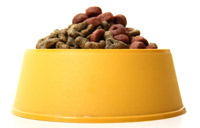For several years now people have been benefiting from the use of Fatty Acid supplements. Now, veterinarians have joined in. Let's review Fatty Acids (FA) and some of the benefits our companion animals get from the daily intake of these supplements.
Fatty Acids are a specific type of polyunsaturated fat. There are two main groups; Omega-3 and Omega-6 Fatty Acids, based on their molecular structure. Animals can produce some FA, but not all of them, so they must be added to their diets. Those that need to be added are called Essential Fatty Acids.
FA in food are easily destroyed by overcooking, improper storage or a sub-optimal amount of antioxidants in the food. As a result, daily supplementation is recommended.
Fatty Acids come from various sources. Beef fat has a small amount of FA. Greater quantities are found in many plants and cold water fish. The appropriate ratio of Omega 6 to Omega 3 FA is also important. The use of a good, reputable formula is highly recommended. Your veterinarian can assist you in choosing an appropriate product.
Fatty Acids have many effects on the body. One of the main functions is assisting the body to fight inflammation. The Omega-3 FA decrease the production of inflammatory substances in the body which results in less inflammation. Some diseases which benefit from this effect are allergic skin disorders, autoimmune conditions, arthritis, renal failure, colitis and inflammatory bowel disease. Nether conditions which benefit from FA are dry, dull hair coats and yeast infections. Dry coats are usually indicative of a deficiency of FA in the skin.
Studies have shown that yeast growth is slowed with FA supplementation in both dogs and cats experiencing skin and ear problems.
Omega-3 FA also provides cardiovascular benefits. Evidence suggests it decreases ventricular arrhythmias and has been shown to reduce blood pressure in dogs.
In higher doses it can have an anti clotting effect on platelets, decreasing the risk of thromboembolisms (blood clots).
Due to their anti-inflammatory properties, Omega-3 FA have a beneficial place in the treatment of cancer. They have also been shown to slow down metastasis. On the other hand, higher dosages of Omega-6 FA can actually stimulate tumor development. This is one of the reasons that a quality product, with the correct ratio of Omega-6 to Omega-3 FA, should be chosen with your animal's specific needs in mind.
Fatty Acids are also good during pregnancy for both the mother and her neonates to strengthen their immune systems. They benefit retinal and brain development as well.
When there is a medical problem, FA alone may not alleviate most clinical signs. The supplement in conjunction with other treatments is necessary. Many times the use of FA can decrease the dose of steroids needed to treat a problem such as pruritus, the itching associated with skin allergies.
The side effects associated with FA supplements are rare and few. One is pancreatitis, which causes pain, vomiting and diarrhea. This is very rare but it is serious should if occur. Other side effects can include diarrhea, weight gain and fishy breath if a fish oil based supplement is used. Start the supplement at a low dose and increase it gradually to prevent diarrhea. Diet adjustment may be needed if a high dose of FA is required.
Again, your veterinarian can assist you in choosing a supplement in the best formulation, dosage and Omega-6 to Omega-3 ratio for your animal's needs.
Timing. Fatty Acids do not have an immediate effect. Pets often need to be treated up to 6 weeks before the positive effects become evident. Don't be impatient, studies have shown this supplement to be very beneficial to your pet's well being, overall health and appearance.
 While corn on its own is not toxic or generally harmful, leftover corn cobs can be dangerous for dogs to eat since they do not digest and many times get stuck somewhere in the digestion tract causing partial or complete obstruction.
While corn on its own is not toxic or generally harmful, leftover corn cobs can be dangerous for dogs to eat since they do not digest and many times get stuck somewhere in the digestion tract causing partial or complete obstruction.
 EN
EN  PL
PL  ES
ES  HR
HR 

 It's been several months since tainted pet food was recalled, but we still receive many questions about it. Let's review facts about the contamination and then look at renal failure, which is the medical condition caused by the contaminated food.
It's been several months since tainted pet food was recalled, but we still receive many questions about it. Let's review facts about the contamination and then look at renal failure, which is the medical condition caused by the contaminated food. Oral hygiene is an important part of pet care. But many owners don't realize that they need to brush their pet's teeth. Ask your veterinarian to show you the proper technique and to offer suggestions on how to get your pet accustomed to brushing. Poor oral health can lead to other health conditions including heart failure. According to the
Oral hygiene is an important part of pet care. But many owners don't realize that they need to brush their pet's teeth. Ask your veterinarian to show you the proper technique and to offer suggestions on how to get your pet accustomed to brushing. Poor oral health can lead to other health conditions including heart failure. According to the 


